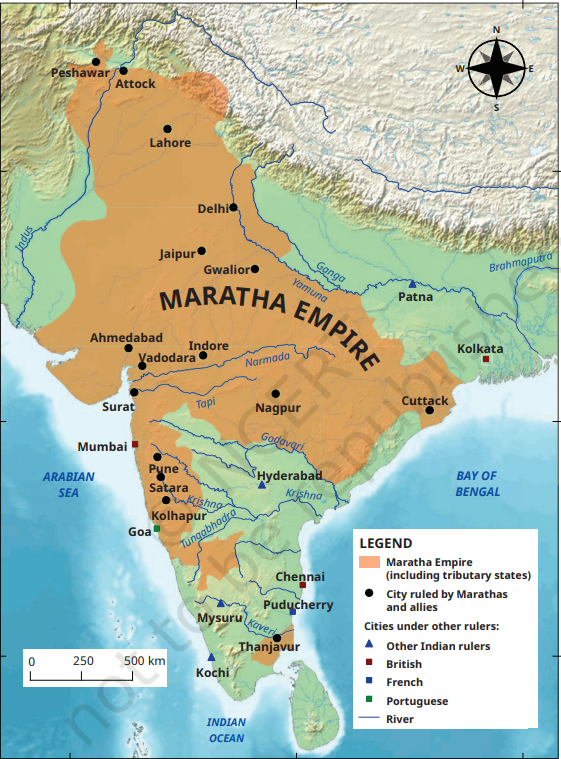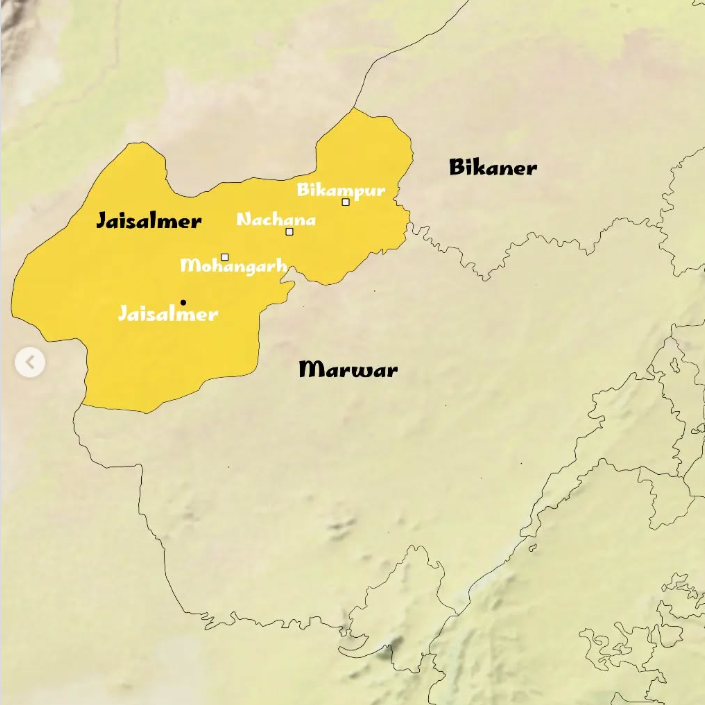Rajasthan
Controversy Over Jaisalmer as Part of Maratha Empire
- 06 Aug 2025
- 4 min read
Why in News?
A historical controversy has erupted following a claim in the NCERT (National Council of Educational Research and Training) textbook where Jaisalmer is depicted as part of the Maratha Empire.
Historians' Arguments on Maratha Relations with Jaisalmer
- Rajput’s Arguments: The royal family of Jaisalmer, led by Chaitanya Raj Singh, the 44th Maharawal of Jaisalmer, has strongly objected to this portrayal, calling it a grave historical error and highlighting that there is no evidence of Maratha influence in Jaisalmer—a region that remained independent throughout various invasions, including those by the Mughals and the British.
- Historical accounts reveal that the region’s Rajput rulers defended their sovereignty, and there was no Maratha intervention or taxation in Jaisalmer.
- Maratha’s Arguments: Maratha historians cite the 1752 Ahadnama (a pact between Mughal Emperor Ahmad Shah Bahadur and Maratha commanders Malharrao Holkar and Mahadji Shinde) and argue that, while the Marathas did not have direct day-to-day control, Rajput states, including Jaisalmer, were made to pay chauth and sardeshmukhi taxes.
- Pandurang Balkawade (historian from Pune) points to Peshwa administration records showing regular collection of chauth from the Ajmer (Mewar) region.
Jaisalmer
- Location & Significance: Jaisalmer, often referred to as the "Golden City," is located in western Rajasthan, close to the Pakistan border and the Thar Desert.
- Its prominent landmark is the Jaisalmer Fort, also known as Sonar Qila (Golden Fort), which is unique for being a living fort.
- Historical Background: Jaisalmer was founded in 1156 by Rawal Jaisal, a descendant of the Yaduvanshi clan. After being passed over for the throne of Lodurva, Jaisal sought a new capital, guided by the prophecy of sage Eesul (local hermit).
- Cultural Heritage: Jaisalmer’s cultural and architectural beauty is shaped by its Rajput heritage, with influences from the Bhati Rajputs.
- Geological Significance: The Wood Fossil Park (Aakal) in Jaisalmer shows fossils from the Thar Desert for a glimpse into geological history, dating back 180 million years.
- Post-Independence: Jaisalmer State signed the Instrument of Accession with India on 7th April 1949, merging with the Indian Union.
Marathas
- Origin & Language: The Marathas (speak Marathi language) are native to the Deccan Plateau, mainly present-day Maharashtra.
- Shivaji Maharaj & the Rise of Maratha Power:
- Born (1630): Shivaji, from the Bhonsle clan, aimed to establish Swarājya (sovereignty).
- Military Campaigns: At 16, he began capturing forts in the Pune region, growing his influence.
- Utilized guerrilla tactics against the Bijapur Sultanate, including defeating General Afzal Khan.
- After Shivaji’s death, Sambhaji (Shivaji’s son) became the Chhatrapati. He was captured and executed by Aurangzeb.
- Maratha Structural Transformation:
- Decentralization: After Shivaji’s death, the Maratha power became more decentralized, with the Peshwa gaining influence.
- Expansion: The Marathas expanded across India, briefly controlling parts of Lahore, Attock, and Peshawar.








